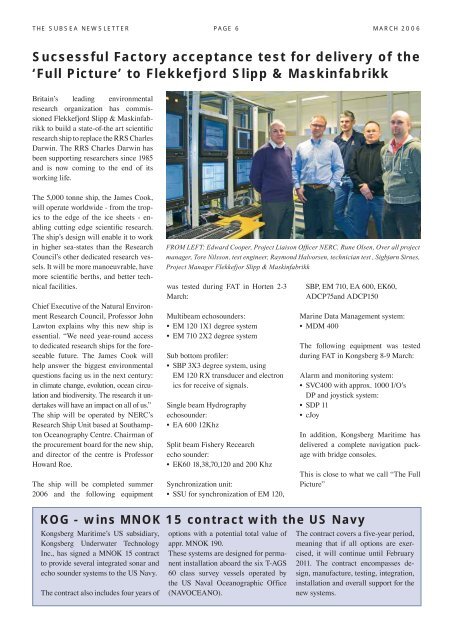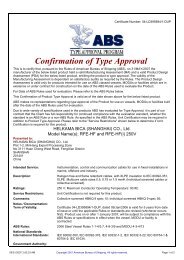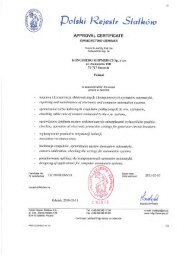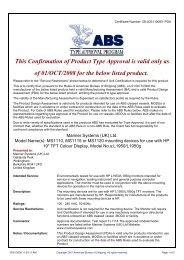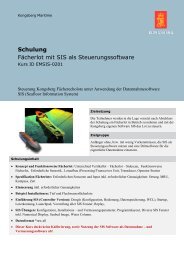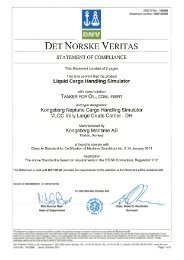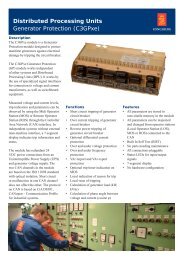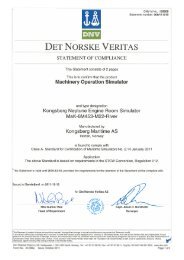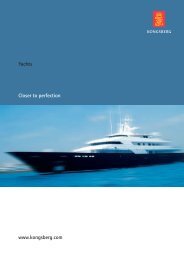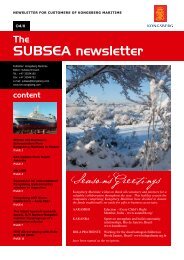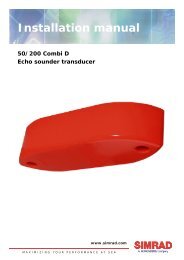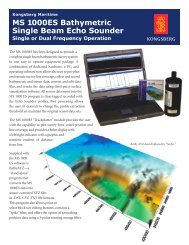March 2006 - Kongsberg Maritime
March 2006 - Kongsberg Maritime
March 2006 - Kongsberg Maritime
Create successful ePaper yourself
Turn your PDF publications into a flip-book with our unique Google optimized e-Paper software.
THE SUBSEA NEWSLETTER PAGE 6<br />
MARCH <strong>2006</strong><br />
Sucsessful Factory acceptance test for delivery of the<br />
‘Full Picture’ to Flekkefjord Slipp & Maskinfabrikk<br />
Britainʼs leading environmental<br />
research organization has commissioned<br />
Flekkefjord Slipp & Maskinfabrikk<br />
to build a state-of-the art scientific<br />
research ship to replace the RRS Charles<br />
Darwin. The RRS Charles Darwin has<br />
been supporting researchers since 1985<br />
and is now coming to the end of its<br />
working life.<br />
The 5,000 tonne ship, the James Cook,<br />
will operate worldwide - from the tropics<br />
to the edge of the ice sheets - enabling<br />
cutting edge scientific research.<br />
The shipʼs design will enable it to work<br />
in higher sea-states than the Research<br />
Councilʼs other dedicated research vessels.<br />
It will be more manoeuvrable, have<br />
more scientific berths, and better technical<br />
facilities.<br />
Chief Executive of the Natural Environment<br />
Research Council, Professor John<br />
Lawton explains why this new ship is<br />
essential. “We need year-round access<br />
to dedicated research ships for the foreseeable<br />
future. The James Cook will<br />
help answer the biggest environmental<br />
questions facing us in the next century:<br />
in climate change, evolution, ocean circulation<br />
and biodiversity. The research it undertakes<br />
will have an impact on all of us.”<br />
The ship will be operated by NERCʼs<br />
Research Ship Unit based at Southampton<br />
Oceanography Centre. Chairman of<br />
the procurement board for the new ship,<br />
and director of the centre is Professor<br />
Howard Roe.<br />
The ship will be completed summer<br />
<strong>2006</strong> and the following equipment<br />
FROM LEFT: Edward Cooper, Project Liaison Offi cer NERC, Rune Olsen, Over all project<br />
manager, Tore Nilsson, test engineer, Raymond Halvorsen, technician test , Sigbjørn Sirnes,<br />
Project Manager Flekkefjor Slipp & Maskinfabrikk<br />
was tested during FAT in Horten 2-3<br />
<strong>March</strong>:<br />
Multibeam echosounders:<br />
• EM 120 1X1 degree system<br />
• EM 710 2X2 degree system<br />
Sub bottom profiler:<br />
• SBP 3X3 degree system, using<br />
EM 120 RX transducer and electron<br />
ics for receive of signals.<br />
Single beam Hydrography<br />
echosounder:<br />
• EA 600 12Khz<br />
Split beam Fishery Recearch<br />
echo sounder:<br />
• EK60 18,38,70,120 and 200 Khz<br />
Synchronization unit:<br />
• SSU for synchronization of EM 120,<br />
SBP, EM 710, EA 600, EK60,<br />
ADCP75and ADCP150<br />
Marine Data Management system:<br />
• MDM 400<br />
The following equipment was tested<br />
during FAT in <strong>Kongsberg</strong> 8-9 <strong>March</strong>:<br />
Alarm and monitoring system:<br />
• SVC400 with approx. 1000 I/Oʼs<br />
DP and joystick system:<br />
• SDP 11<br />
• cJoy<br />
In addition, <strong>Kongsberg</strong> <strong>Maritime</strong> has<br />
delivered a complete navigation package<br />
with bridge consoles.<br />
This is close to what we call “The Full<br />
Picture”<br />
KOG - wins MNOK 15 contract with the US Navy<br />
<strong>Kongsberg</strong> <strong>Maritime</strong>ʼs US subsidiary,<br />
<strong>Kongsberg</strong> Underwater Technology<br />
Inc., has signed a MNOK 15 contract<br />
to provide several integrated sonar and<br />
echo sounder systems to the US Navy.<br />
The contract also includes four years of<br />
options with a potential total value of<br />
appr. MNOK 190.<br />
These systems are designed for permanent<br />
installation aboard the six T-AGS<br />
60 class survey vessels operated by<br />
the US Naval Oceanographic Office<br />
(NAVOCEANO).<br />
The contract covers a five-year period,<br />
meaning that if all options are exercised,<br />
it will continue until February<br />
2011. The contract encompasses design,<br />
manufacture, testing, integration,<br />
installation and overall support for the<br />
new systems.


